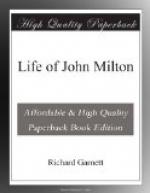The external aspect of Milton’s Cambridge is probably not ill represented by Lyne’s coloured map of half a century earlier, now exhibited in the King’s Library at the British Museum. Piles of stately architecture, from King’s College Chapel downward, tower all about, over narrow, tortuous, pebble-paved streets, bordered with diminutive, white-fronted, red-tiled dwellings, mere dolls’ houses in comparison. So modest, however, is the chartographer’s standard, that a flowery Latin inscription assures the men of Cambridge they need but divert Trumpington Brook into Clare Ditch to render their town as elegant as any in the universe. Sheep and swine perambulate the environs, and green spaces are interspersed among the colleges, sparsely set with trees, so pollarded as to justify Milton’s taunt when in an ill-humour with his university:—
“Nuda nec arva placent, umbrasque
negantia molles,
Quam male Phoebicolis convenit
ille locus!”
His own college stands conspicuous at the meeting of three ways, aptly suggestive of Hecate and infernal things. Its spiritual and intellectual physiognomy, and that of the university in general, must be learned from the exhaustive pages of Professor Masson. A book unpublished when he wrote, Ball’s life of Dr. John Preston, Master of Emmanuel, vestige of an entire continent of submerged Puritanism, also contributes much to the appreciation of the place and time. We can here but briefly characterize the University as an institution undergoing modification, rather by the decay of the old than by the intrusion of the new. The revolution by which mathematics became the principal instrument of culture was still to be deferred forty years. Milton, who tells us that he delighted in mathematics, might have been nearly ignorant of that subject if he pleased, and hardly could become proficient in it by the help of his Alma Mater. The scholastic philosophy, however, still reigned. But even here tradition was shaky and undermined; and in matters of discipline the rigid code which nominally governed the University was practically much relaxed. The teaching staff was respectable in character and ability, including many future bishops. But while the academical credentials of the tutors were unimpeachable, perhaps not one among them all could show a commission from the Spirit. No one then at Cambridge seems to have been in the least degree capable of arousing enthusiasm. It might not indeed have been easy for a Newman or a Green to captivate




